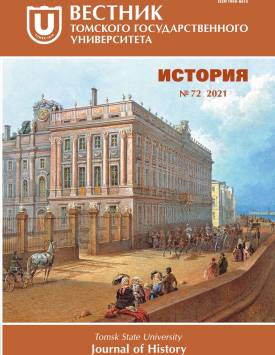Prison terror of revolutionaries in the Russian Empire
The paper presents the analysis of the phenomenon of the prison terror in the early 20th century. The terror manifested itself in multiple attacks of revolutionaries on the officers of the penitentiary system in the Russian Empire. Drawing upon the analysis of the archive records, mass media publications, published memoirs and materials on the previous research, the author presents conclusions concerning the reasons for the emergence, development and specific features of the terrorist aggression towards prison officers. The paper analyzes the well-known cases of prison terror and claims that during the «narodnik» period these attacks were classified as «assault and battery», e.g., slaps in the face given by political prisoners to prison authorities. More then a dozen of such attacks were documented during the “narodnik” period. Terrorist assaults of the prison officers first occurred in the circumstances of a deep political crisis caused by the First Russian revolution in 1905-1907. Terrorist acts were mostly sanctioned by party committees armed assaults of the combatants who used either shotguns or explosives. The author points out that the starting point of the prison terror was the response of the society to the police tortures of the female terror activist M. Spiridonova. Despite denunciation of the fact confirmed by the official investigation, social-revolutionaries organized assassination of Spiridonova’s torturers. Massive social support of these assassinations allowed the revolutionaries to talk about “social justice” and initiated a widely accepted practice of attacks on the prison “torturers”. The most infamous and cruel officers and prison authorities became the most popular victims of such attacks. Starting from 1906, armed attacks in prisons came into practice. To carry out the assault, the prisoners either made weapons themselves or asked to smuggle them from outside. The level of prison terror from 1906 to 1913 can be measured by several hundreds of killed and wounded prison officers. Various official administrative departments presented different statistics of attacks and even the Main prison department could not publish exact numbers. The main reasons which caused the prison terror were the desire to take revenge and to appeal to society along with the protest against the oppressive character of the Russian penitentiary system and the absence of the uniform order in prisons, which was amplified by the cruelty of local prison administrations.
Keywords
the First Russian revolution of 1905-1907, prison, revolutionary terrorAuthors
| Name | Organization | |
| Kvasov Oleg N. | Voronezh State University of Forestry and Technologies named after G.F. Morozov | kvasovoleg@yandex.ru |
References

Prison terror of revolutionaries in the Russian Empire | Tomsk State University Journal of History. 2021. № 72. DOI: 10.17223/19988613/72/6
